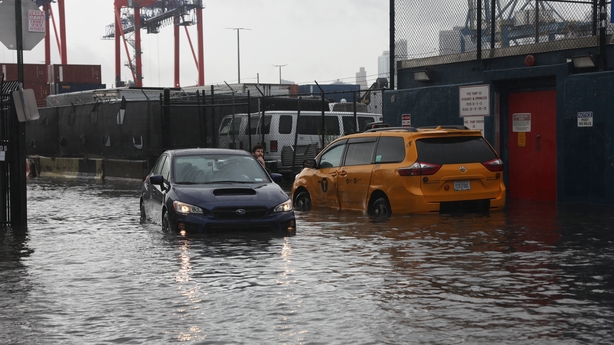Torrential downpours after a week of mostly steady rainfall has triggered flash flooding in New York City, disrupting subway services in the most populous city in the US, turning many of the city's streets into small lakes.
A flash flood warning was in effect for New York until 2.30pm local time, with as much as 15cm of rain falling in some locations, including Brooklyn, lower Manhattan and John F. Kennedy International Airport in the borough of Queens, according to the National Weather Service.
It also said that across the region, another 5 to 8 cm could fall before the system pushed out to sea, and some locations could see even more.
"This is seriously a life-threatening situation," said a meteorologist from the NWS, warning against travel until the rainfall abated later on this evening.
The extreme rainfall prompted New York Governor Kathy Hochul to declare a state of emergency for New York City, Long Island, and the Hudson Valley, and some National Guard troops were deployed to assist in the response.
Flooding caused major disruptions to New York's subway service and the Metro-North commuter rail service, according to the Metropolitan Transportation Agency, which operates both. Some subway lines were suspended entirely, and many stations were closed.
New York Mayor Eric Adams declared a state of emergency for the city.
"This is time for heightened alertness and extreme caution," he said at a morning news conference. "If you are at work or school, shelter in place for now."
Systems producing intense rainfalls such as today have become more common in many parts of the US, including the New York City area.
Global warming has produced more extreme weather patterns in many parts of the world, according to climate scientists.
The rain capped one of New York's wettest Septembers on record, with 34.9cm of rain falling during the month as of 11am today, and more on the way, according to one forecaster in the city. The all-time high was set in September 1882 when 42.72cm of rain fell.
Despite the warnings, the city's public schools were open for the day. Some buildings experienced flooding but no operations were affected, a district spokesperson said.
At least one suburban district, Bronxville in New York's Westchester County north of New York, dismissed students early because of the worsening flooding.

Floodwaters marooned vehicles on neighbourhood streets and poured into subway stations, disrupting morning traffic for millions of commuters.
Mohammed Doha, a 52-year-old construction worker who lives in a ground-level, two-bedroom apartment in The Hole, a low-lying wedge of blocks on the border between Brooklyn and Queens, walked through water in his kitchen.
"If they would have a proper drainage system like the other areas of the city, then we wouldn't have this problem," he said. "We are really, really suffering."
Yasiel Ogando, a 38-year-old hospital worker who lives in The Hole with her family, complained that the city gave residents no warning about the flooding.
Neighbourhood meetings with city officials to make their area less prone to flooding have gone nowhere.
"Broken promises," she said, after a morning trying to bail water mixed with sewage out of the basement of the family home. "Nothing gets done. It's really bad. It's terrible."
In neighbouring New Jersey, low-lying Hoboken, a city directly across the Hudson River from lower Manhattan, declared a state of emergency, with all but one of the southern routes into town under water.
The city's newly installed floodgates, designed to close automatically when water pooled on roadways, were down, blocking many streets to vehicular traffic.
Today's heavy rain followed a bout of heavy downpours and unrelenting winds last weekend from the remnants of Tropical Storm Ophelia. That storm soaked New York City and caused widespread power outages in North Carolina, Virginia, Pennsylvania and New Jersey.
In New York, intermittent rain this week further saturated the ground, setting up conditions conducive to flash flooding.

